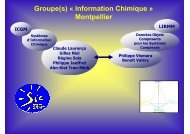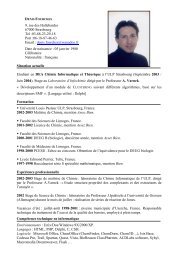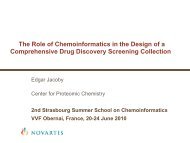International Summer School PROGRAM - Laboratoire d'Infochimie ...
International Summer School PROGRAM - Laboratoire d'Infochimie ...
International Summer School PROGRAM - Laboratoire d'Infochimie ...
You also want an ePaper? Increase the reach of your titles
YUMPU automatically turns print PDFs into web optimized ePapers that Google loves.
Mirco- and Mesoporous Coordination Polymers: Synthesis, Structure<br />
and Properties<br />
Vladimir P. Fedin<br />
Nikolaev Institute of Inorganic Chemistry SB RAS, 630090 Novosibirsk, Russia<br />
Synthesis, structure and functional properties of microporous and mesoporous metal-<br />
organic coordination polymers will be considered. Hybrid MIL-101/polyoxotungstate<br />
materials were used for selective oxidation of a range of alkenes with aqueous hydrogen<br />
peroxide. The selectivities toward epoxides were comparable or even superior to the<br />
corresponding homogeneous polyoxotungstates and strongly depended on the alkene<br />
nature. Under the reaction conditions employed, the hybrid materials were stable to<br />
leaching, behaved as true heterogeneous catalysts and could be used repeatedly several<br />
times without suffering a loss of the activity and selectivity.<br />
Enantiopure (homochiral) porous absorbents provide great opportunities for<br />
stereoselective sorption of chiral guest molecules and therefore highly demanded for<br />
separation and purification of important substrates including drugs and other bioactive<br />
molecules. Porous homochiral coordination polymers represent promising class of<br />
porous chiral absorbents due to high versatility of structural design; however the<br />
synthetic accessibility still remains a challenging problem here. Starting from<br />
enantiopure lactic, mandelic, camphoric, malic and aspartic acids we obtained series of<br />
homochiral porous coordination polymers with isoreticular topologies. These structures<br />
share the same building chiral motif with rigid linkers controlling the important<br />
structural properties (the pore sizes, free accessible volumes) and stability of the metal-<br />
organic frameworks upon guest exchange. These structures were shown to possess<br />
remarkable size- and enantioselective sorption properties toward chiral alcohols and sulfoxides.<br />
More important, some chiral drug precursors also show notable enantioselectivity upon<br />
inclusion into these homochiral porous coordination polymers.<br />
The research was partially supported by the Russian Foundation for Basic Research<br />
(11-03-00112) and Russian Academy of Sciences (program 5.6.1).









